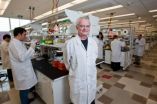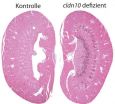(Press-News.org) PHILADELPHIA—It's widely accepted that molecular mechanisms mediating epigenetics include DNA methylation and histone modifications, but a team from Thomas Jefferson University has evidence to the contrary regarding the role of histone modifications.
A study of Drosophila embryos from Jefferson's Department of Biochemistry and Molecular Biology published ahead of print in Cell August 23 found that parental methylated histones are not transferred to daughter DNA. Rather, after DNA replication, new nucleosomes are assembled from newly synthesized unmodified histones.
"Essentially, all histones are going away during DNA replication and new histones, which are not modified, are coming in," said Alexander M. Mazo, Ph.D., professor of Biochemistry and Molecular Biology at Jefferson, and a member of Jefferson's Kimmel Cancer Center. "In other words, what we found is that histone modifying proteins are hiding on the way over replicating DNA, instead of histones 'jumping' over as currently thought."
"What this paper tells us," he continues, "is that these histone modifying proteins somehow are able to withstand the passage of the DNA replication machinery. They remained seated on their responsive binding sites, and in all likelihood they will re-establish histone modification and finalize the chromatin structure that allows either activation or repression of the target gene."
The team suggests that since it appears these histone modifying proteins—the Trithorax-group (TrxG), which maintain gene expression, and the Polycomb-group (PcG), which plays a role in epigenetic silencing of genes—re-establish the histone code on newly assembled unmethylated histones, they may act as epigenetic marks.
Epigenetics is the study of heritable changes in gene expression caused by mechanisms other than changes in the underlying DNA sequence. Epigenetic marks have become an important focus in recent years because they are thought to have the potential to explain mechanisms of aging, human development, and the origins of diseases, like cancer, heart disease, and mental illness.
According to widely-accepted models applied today, the tails of methylated histones turn genes in DNA "on" or "off" by loosening or tightening nucleosome structure, thus changing the accessibility of transcription factors and other proteins to DNA.
"People believe that everything gets worked off of DNA during the replication process and that these methylated histones act as epigenetic marks, since they are believed to rapidly jump from parental to daughter DNA" said Dr. Mazo. "But there is no experimental evidence to back this up."
The researchers used chromatin immunoprecipitation (ChIP) assay, and developed several new approaches to analyze protein interactions with newly synthesized DNA, tracking both modified and unmodified histones, and non-histone proteins to determine their presence and role from the initial split of DNA through the various embryonic stages.
This new evidence that TrxG and PcG proteins but not methylated histones remain associated with DNA through replication could have significant impacts on how scientists study epigenetic marks.
Instead of focusing on numerous types of modified histones, it is probably more practical to assess which non-histone proteins remain stably associated with their sites on DNA following DNA replication, as they may potentially carry essential epigenetic information by restoring the state of histone modifications in the daughter cell, according to Dr. Mazo.
"It is also important to understand whether the way nucleosomes are assembled in mammalian cells is similar to that detected in Drosophila embryos and whether these mechanisms remain unchanged during cell differentiation in development and disease," he added.
INFORMATION: END
People will reject an offer of water, even when they are severely thirsty, if they perceive the offer to be unfair, according to a new study funded by the Wellcome Trust. The findings have important implications for understanding how humans make decisions that must balance fairness and self-interest.
It's been known for some time that when humans bargain for money they have a tendency to reject unfair offers, preferring to let both parties walk away with nothing rather than accept a low offer in the knowledge that their counterpart is taking home more cash.
In contrast, ...
HOUSTON, Aug. 23, 2012 – Scientists at the University of Houston (UH) have discovered what may possibly be a key ingredient in the fight against Parkinson's disease.
Affecting more than 500,000 people in the U.S., Parkinson's disease is a degenerative disorder of the central nervous system marked by a loss of certain nerve cells in the brain, causing a lack of dopamine. These dopamine-producing neurons are in a section of the midbrain that regulates body control and movement. In a study recently published in the Proceedings of the National Academy of Sciences (PNAS), ...
The discovery of a 'switch' that modifies a gene known to be essential for normal heart development could explain variations in the severity of birth defects in children with DiGeorge syndrome.
Researchers from the Walter and Eliza Hall Institute made the discovery while investigating foetal development in an animal model of DiGeorge syndrome. DiGeorge syndrome affects approximately one in 4000 babies.
Dr Anne Voss and Dr Tim Thomas led the study, with colleagues from the institute's Development and Cancer division, published today in the journal Developmental Cell.
Dr ...
Sodium chloride, better known as salt, is vital for the organism, and the kidneys play a crucial role in the regulation of sodium balance. However, the underlying mechanisms of sodium balance are not yet completely understood. Researchers of the Max Delbrück Center for Molecular Medicine (MDC) Berlin-Buch, Charité – Universitätsmedizin Berlin and the University of Kiel have now deciphered the function of a gene in the kidney and have thus gained new insights into this complex regulation process (PNAS Early Edition, doi/10.1073/pnas.1203834109)*.
In humans, the kidneys ...
They are one of the most destructive forces of nature on Earth, but now environmental scientists are working to tame the hurricane. In a paper, published in Atmospheric Science Letters, the authors propose using cloud seeding to decrease sea surface temperatures where hurricanes form. Theoretically, the team claims the technique could reduce hurricane intensity by a category.
The team focused on the relationship between sea surface temperature and the energy associated with the destructive potential of hurricanes. Rather than seeding storm clouds or hurricanes directly, ...
Vancouver, BC – August 23, 2012 – Vancouver-based clinician and researcher Dr. Andrei Krassioukov is packing for the upcoming Paralympic games in London. Rather than packing sports equipment, he has a suitcase full of advanced scientific equipment funded by the Canada Foundation for Innovation that he will use to monitor the cardiovascular function of athletes with spinal cord injuries.
Up to 90% of people with injuries between that cervical and high thoracic vertebrae suffer from a condition that limits their ability to regulate heart rate and blood pressure. For top-level ...
Scientists at the University of Cambridge have produced hydrogen, H2, a renewable energy source, from water using an inexpensive catalyst under industrially relevant conditions (using pH neutral water, surrounded by atmospheric oxygen, O2, and at room temperature).
Lead author of the research, Dr Erwin Reisner, an EPSRC research fellow and head of the Christian Doppler Laboratory at the University of Cambridge, said: "A H2 evolution catalyst which is active under elevated O2 levels is crucial if we are to develop an industrial water splitting process - a chemical reaction ...
CAMBRIDGE, MA -- The discovery of graphene, a material just one atom thick and possessing exceptional strength and other novel properties, started an avalanche of research around its use for everything from electronics to optics to structural materials. But new research suggests that was just the beginning: A whole family of two-dimensional materials may open up even broader possibilities for applications that could change many aspects of modern life.
The latest "new" material, molybdenum disulfide (MoS2) — which has actually been used for decades, but not in its 2-D ...
ARLINGTON, Va.—The Office of Naval Research (ONR) is demonstrating the next phase of an augmented-reality project Aug. 23 in Princeton, N.J., that will change the way warfighters view operational environments—literally.
ONR has completed the first year of a multi-year augmented-reality effort, developing a system that allow trainees to view simulated images superimposed on real-world landscapes. One example of augmented reality technology can be seen in sports broadcasts, which use it to highlight first-down lines on football fields and animate hockey pucks to help TV ...
Spacetime may be less like beer and more like sipping whiskey.
Or so an intergalactic photo finish may suggest.
Physicist Robert Nemiroff of Michigan Technological University reached this heady conclusion after studying the tracings of three photons of differing wavelengths that were recorded by NASA's Fermi Gamma-ray Space Telescope in May 2009.
The photons originated about 7 billion light years away from Earth in one of three pulses from a gamma-ray burst. They arrived at the orbiting telescope just one millisecond apart, in a virtual tie.
Gamma-ray bursts are ...

